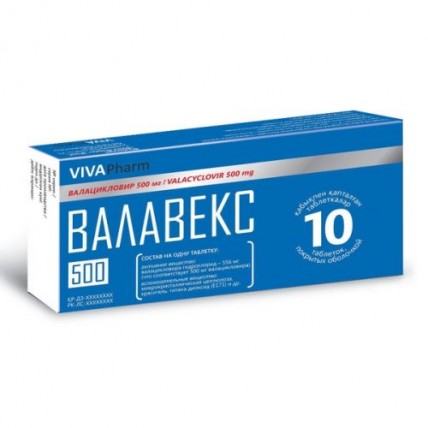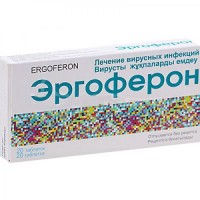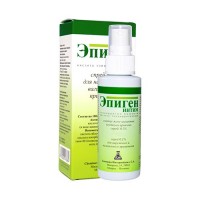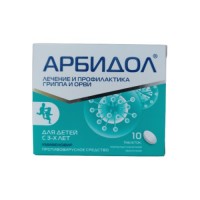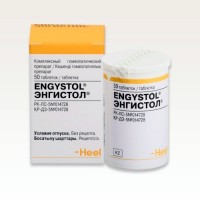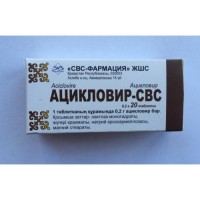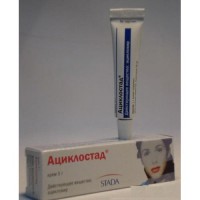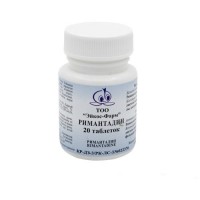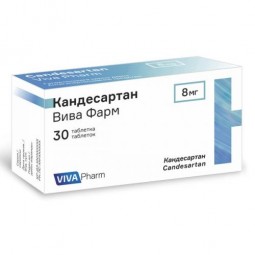Valaveks 10s 500 mg coated tablets
- $34.00
VALAVEKS
A trade name
of Valavex
the International unlicensed
name Valatsiklovir Lekarstvennaya
the Tablet form, coated, 500 mg
Structure
One tablet contains
active agent of a valatsiklovir a hydrochloride of 556 mg (equivalent to a valatsiklovir of 500 mg),
excipients: microcrystalline cellulose, krospovidon, povidone, silicon dioxide colloidal (Aerosil 200), magnesium stearate,
structure of a cover: Opadri II white (85F18422): titan dioxide (E 171), polyethyleneglycol 6000, talc, polyvinyl alcohol.
The description
of the Tablet of oblong shape, with a biconvex surface, coated white color.
Pharmacotherapeutic group
Antiviral drugs for system use. Nucleosides and nucleotides.
ATX J05AB11 code
the Pharmacological
Pharmacokinetics Later properties of intake valatsiklovir is well soaked up from digestive tract, quickly and almost completely turning into acyclovir and valine. This transformation is catalyzed by enzyme valatsiklovirgidralazy, allocated from a liver of the person. After single dose of a valatsiklovir in a dose of 250-2000 mg the average peak concentration of acyclovir in plasma at healthy volunteers with normal function of kidneys makes 10-37 µmol (2.2 - 8.3 mkg/ml), and a median of time of achievement of this concentration 1-2 hours. At reception of a valatsiklovir from 1000 mg the bioavailability of acyclovir is equal in a dose to 54% and does not depend on meal. Peak concentration of a valatsiklovir in plasma makes only 4% of concentration of acyclovir, the median of time of its achievement of 30 - 100 minutes after reception of a dose, in 3 hours the level of peak concentration remains former or decreases. Valatsiklovir and acyclovir have similar pharmacokinetic parameters after intake. Extent of linking of a valatsiklovir with proteins of plasma is very low (only 15%). At patients with normal function of kidneys the elimination half-life of acyclovir after reception of a valatsiklovir makes about 3 hours of plasma, and patients with a final stage of a renal failure have an average elimination half-life about 14 hours. Valatsiklovir is brought from an organism with urine mainly in the form of acyclovir (more than 80% of a dose) and an acyclovir metabolite - a 9-karboksimetoksimetilguanin, in not changed look less than 1% of drug eliminirutsya.
The pharmacokinetics of a valatsiklovir and acyclovir substantially is not broken at the patients infected with viruses of the herpes simplex (HS) and the virus zoster (VZ).
In the late stages of pregnancy the steady daily indicator the area under a curve (the area under a ratio curve plasma concentration / time) after reception of 1000 mg of a valatsiklovir was approximately twice more, than that at intake of acyclovir in a dose of 1200 mg a day. Valavex's reception in a dose of 1000 mg or 2000 mg does not break a disposition and pharmacokinetic indicators of a valatsiklovir at HIV-positive patients in comparison with healthy faces.
At recipients of transplants of the bodies receiving valatsiklovir in a dose of 2000 mg 4 times a day, the peak of concentration of acyclovir is equal or exceeds that at the healthy volunteers receiving the same dose of drug, and daily indicators the area under a curve at them are much higher.
The pharmacodynamics
In a human body of Valavex quickly and completely turns into acyclovir, under the influence of valatsiklovirgidrolaza enzyme. In vitro acyclovir has the specific inhibiting activity against the herpes simplex viruses (HSV) of the 1st and 2nd types, the virus of a varitsell zoster (VVZ), a cytomegalovirus (CMV), the virus Epstein-Burra (VEB) and a virus of herpes of the person of the 6th type. Acyclovir inhibits synthesis of virus DNA right after phosphorylation and transformation into an active form - acyclovir triphosphate.
The first stage of phosphorylation demands activity a virus - specific enzymes. For VPG, VVZ, and VEB such enzyme is a virus thymidinekinase which is present at the cells affected with a virus. The partial selectivity of phosphorylation remains at a cytomegalovirus and is mediated through a product of a gene of UL 97 phosphotransferase. Acyclovir activation by specific virus enzyme in huge degree explains its selectivity. Process of phosphorylation of acyclovir comes to the end with cellular kinases. Acyclovir triphosphate competitively inhibits a virus DNA-polymerase and, being a nucleoside analog, is built in virus DNA that leads to an obligate rupture of a chain, the termination of synthesis of DNA and, therefore, to blocking of replication of a virus. With the kept immunity of VPG and VVZ with hyposensitivity to a valatsiklovir meet at patients extremely seldom, but can be sometimes found in patients with heavy disturbance of immunity, for example, with a marrow transplant, at receiving chemotherapy concerning malignant new growths and at HIV-positive people. The resistance is usually caused by deficit of a thymidinekinase that leads to excessive spread of a virus in the owner's organism. Sometimes decrease in sensitivity to acyclovir is caused by emergence of virus strains with disturbance of structure of a virus thymidinekinase or DNA polymerase. Virulence of these types of a virus reminds that at its wild strain.
Indications
- the shingles caused by a herpes virus a zoster
- an infection of skin and the mucous membranes caused by VPG, including for the first time the revealed and recurrent genital herpes
- prevention (suppression) of a recurrence of infections of skin and the mucous membranes caused by a herpes simplex virus including genital herpes
- labial herpes (lip fever)
- prevention of development of rashes at use in process of emergence of the first symptoms of a recurrence of a herpes simplex
- suppressive therapy for decrease in infection with genital herpes of the healthy partner in combination with safe sex
- prevention of a Cytomegaloviral infection (CMV) arising at organ transplantation.
The route of administration and doses
Treatment of shingles
At adult Valavex is appointed in a dose of 1000 mg 3 times a day within 7 days.
Treatment of the infections caused
by VPG U of adults of Valavex is appointed in a dose of 500 mg 2 times a day.
In case of a recurrence the treatment has to continue 3 or 5 days. In more hard primary cases the treatment should be begun, as soon as possible, and its duration has to be increased from 5 to 10 days. At VPG recurrence the purpose of Valavex in a prodromal stage or at once after emergence of the first symptoms of a disease is considered ideal. As an alternative for treatment of labial herpes (lip fever) the purpose of Valavex in a dose of 2 g twice within 1 day is effective. The second dose has to be accepted approximately in 12 hours (but not earlier, than in 6 hours) after reception of the first dose.
When using such mode of dosing duration of treatment should not exceed 1 day as it as it was shown, does not give additional clinical benefits. Therapy has to be begun at emergence of the earliest symptoms of lip fever (i.e. tingling, an itching, burning).
Prevention (suppression) of a recurrence of the infections caused
by VPG U of adult patients with the kept immunity of Valavex is appointed in a dose of 500 mg once a day. With very frequent recurrence (10 and more in a year) the additional effect can achieve from patients when assigning Valavex in the daily dose of 500 mg divided into 2 receptions (on 250 mg 2 times a day). For adult patients with an immunodeficiency the recommended dose of Valavex makes 500 mg 2 times a day. Treatment duration - 4 12 months.
Prevention of infection with genital herpes of the healthy partner
by the Infected heterosexual adult with the kept immunity and with number of aggravations to 9 times a year, Valavex it is necessary to accept 500 mg within a year and more once a day - every day at regular sex life, at irregular sexual contacts the reception Valavex needs to be begun in 3 days prior to expected sexual contact.
Data on prevention of infection in other populations of patients do not exist.
Prevention of CMV of an infection
of the Dose for adults and teenagers (from 12 years)
Is recommended to appoint Valavex in a dose 2 g 4 times a day, as soon as possible after transplantation. The dose should be reduced depending on clearance of creatinine. Duration of treatment is 90 days, but at patients with high risk, treatment can be longer.
Doses in a renal failure
the Treatment of shingles and the infections caused by VPG, prevention (suppression) and decrease in infection of the healthy partner
is recommended to reduce Valavex's Dose at patients with considerable depression of function of kidneys (see doses in a renal failure in the table).
Therapeutic indications
Clearance of creatinine
of ml/min.
Valavex
Opoyasyvayushchy's Dose herpes
15-30
less than 15
1 g 2 times in day
of 1 g of 1 times a day
the Herpes simplex (treatment)
less than 15,500 mg of 1 times a day
Labial herpes (treatment) (2 g in 2 receptions within 1 day)
31-49
15-30
less than 15
1 g twice within 1 day
of 500 mg twice within 1 day
of 500 mg once
the Herpes simplex prevention:
- patients with the kept immunity
- patients with reduced immunity
less than 15
250 mg of 1 times in day
of 500 mg of 1 times a day
Decrease in infection with genital herpes
less than 15,250 mg of 1 times a day
to the Patients who are on a hemodialysis Valavex right after the end of a session of a hemodialysis in the same dose as to patients with clearance of creatinine less than 15 ml/min. is recommended to apply less than 15.
Prevention of CMV
the Mode of appointment of Valavex at patients with a renal failure has to be set according to this table:
Valavex's Dose
from 50 to less than 75
from 25 to less than 50
from 10 to less than 25
less than 10 or dialysis *
2 g 4 times in day
of 1.5 g 4 times in day
of 1.5 g 3 times in day
of 1.5 g 2 times in day
of 1.5 g of 1 times a day
* - at the patients who are on a hemodialysis it is necessary to appoint clearance of creatinine of ml/min. 75 and more Valavex in the dose recommended for patients with clearance of creatinine less than 15 ml/min. after the end of a session of a hemodialysis. It is necessary to define often clearance of creatinine, especially during the periods when function of kidneys quickly changes, for example, right after transplantation or during engraftment of a transplant, at the same time Valavex's dose is adjusted according to indicators of clearance of creatinine.
Valavex's dose in an abnormal liver function
with poorly and moderate cirrhosis (synthetic function of a liver is kept) corrections of a dose Valavex is not required From patients. Pharmacokinetic data at patients with heavy cirrhosis (with disturbance of synthetic function of a liver and existence of shunts between a portal system and the general vascular bed) also do not confirm need to adjust doses Valavex, however, experience of its clinical use in this pathology is limited.
Use for elderly people
of Correction of a dose is not required, except for a considerable renal failure. It is necessary to maintain adequate water and electrolytic balance.
Side effects
Undesirable reactions are listed below on emergence frequency.
The used frequency indicators:
Very often: 1 na10,
it is frequent: 1 na100 или<, 1 on 10,
Infrequently: 1 on 1000 or & lt, 1 na100,
is rare: 1 na10000 or & lt, 1 on 1000,
Is very rare: & lt, 1 on 10000.
Often
- a headache
- nausea
Infrequently
- an asthma
- rashes, including manifestations of photosensitivity
it is rare
- dizziness, confusion of consciousness, a hallucination, decrease in mental capacities
- discomfort in a stomach, vomiting, diarrhea
- an itching
- renal failures
It is very rare
- a leukopenia, thrombocytopenia. Generally the leukopenia was noted at patients with reduced immunity.
- an anaphylaxis
- excitement, a tremor, an ataxia, a dysarthtia, psychotic symptoms, spasms, encephalopathy, a coma
- reversible disturbances of functional hepatic tests which sometimes regard as manifestations of hepatitis
- a small tortoiseshell a Quincke's disease
- an acute renal failure
the Listed above symptoms are reversible and are usually observed at patients with disturbance of renal function or against the background of other contributing states. At the patients with a transplanted organ receiving high doses (8 g a day) Valavex for prevention of CMV of an infection, neurologic reactions develop more often than at reception of lower doses.
At patients with heavy disturbances of immunity, especially at the patients with far come stage of AIDS receiving high doses of a valatsiklovir (8 g daily) during the long span, cases of a renal failure, mikroangiopatichesky hemolytic anemia and thrombocytopenia were observed (sometimes in a combination). Similar complications were noted at the patients with the same diseases but who are not receiving valatsiklovir.
Contraindications
- hypersensitivity to the valatsiklovir, acyclovir and any auxiliary ingredient which is a part of drug
- clinically apparent forms of HIV infection
- children's age up to 12 years (prevention of CMV of an infection)
Medicinal interactions
Clinically significant interactions are not established. Acyclovir eliminirutsya by urine generally in not changed look, actively cosecreting in renal tubules. After purpose of 1 g of Valavex Cimetidinum and probenetsid, blocking canalicular secretion, raise AUC acyclovir and reduce its renal clearance. However this dose of Valavex does not demand any correction because of the wide therapeutic index of acyclovir. It is necessary to be careful in case of simultaneous use of Valavex in higher doses (4 g a day) and medicines which compete with acyclovir for a way of elimination as there is a potential threat of increase in plasma of level of one or both drugs or their metabolites. Increase in AUC acyclovir and an inactive metabolite of the mikofenolat of a mofetil - the immunosuppressive drug used at transplantation, at simultaneous use of these drugs was noted. It is necessary to be careful also (to watch change of function of kidneys) at Valavex's combination in higher doses (4 g a day and more) with drugs which affect functions of kidneys (for example, cyclosporine, takrolimus).
The special
instructions Use in shingles, the caused herpes virus the zoster of Valavex reduces duration of pains and percent of patients with the pains caused by shingles including acute and post-herpetic neuralgia.
Prevention of a Cytomegaloviral infection (CMV) arising at organ transplantation
Preventive appointment of Valavex at CMV of an infection weakens expressiveness of reaction of acute graft rejection (at patients with transplants of kidneys), opportunistic infections and other gerpesny viral infections (VPG, VVZ).
Extent of hydration of an organism
At patients with risk of dehydration, especially at patients of advanced age, it is necessary to provide adequate completion of liquid.
Use in a renal failure
the Dose has to be adjusted depending on degree of a renal failure. Patients with a renal failure have the increased risk of development of neurologic complications.
Use of higher doses of Valavex in a liver failure and transplantation of a liver
Is not present data on Valavex's use in higher doses (4 g or any more in day) at patients with a liver disease therefore high doses of Valavex to them have to be appointed with care. Special researches on studying action of Valavex at liver transplantation were not conducted. However it was shown that preventive prescribing of acyclovir in high doses reduces CMV an infection.
Use in genital herpes
of Supressivnaya the therapy by Valavex reduces risk of transfer of genital herpes, but does not exclude it completely and does not lead to full treatment. Therapy by Valavex is recommended in combination with safe sex.
Use in pediatrics
Is not present data on Valavex's use for children, except for use for children from 12 years - for prevention of CMV of an infection.
Pregnancy and the period of a lactation
of Data on Valavex's use at pregnancy are not enough. Valavex it is necessary to apply at pregnancy only if the potential advantage for mother exceeds potential risk for a fruit.
Data of registration records about the result of pregnancy at the women accepting Valavex did not show increase in number of congenital defects at their children in comparison with the general population. As clinical trials included a small amount of the women accepting Valavex during pregnancy, the authentic and certain conclusions about safety of drug at pregnancy cannot be made.
Acyclovir, the main metabolite of a valatsiklovir, is excreted by breast milk. After Valavex's appointment in a dose of 500 mg inside the maximum concentration of acyclovir (Cmax) in breast milk by 0.5-2.3 times (on average by 1.4 times) exceeded the corresponding concentration of acyclovir in mother's plasma. The relation of AUC of the acyclovir which is in breast milk to AUC acyclovir of plasma of mother fluctuated from 1.4 to 2.6 (average value 2.2). The average value of concentration of acyclovir in breast milk was 2.24 mkg/ml (9.95 mkgm). At reception by mother of a valatsiklovir in a dose of 500 mg 2 times a day the child will undergo the same influence of acyclovir, as at its reception inside in a dose about 0.61 mg/kg/day. Elimination half-life of acyclovir from breast milk same, as from blood plasma. Valatsiklovir in not changed look was not defined in mother's plasma, breast milk or the child's urine. Valavex the feeding women should appoint with care.
Features of influence on ability to run the vehicle and potentially dangerous mechanisms
Special precautions are not required.
Overdose
Symptoms: data on Valavex's overdose are insufficient. Single dose of a superdose of acyclovir up to 20 g which was partially absorbed from digestive tract was not followed by toxic effect of drug. Intake within several days of ultrahigh doses of acyclovir was associated with gastrointestinal (nausea and vomiting) and neurologic symptoms (headache and confusion of consciousness). Superdoses at intravenous administration of acyclovir are followed by increase in level of serumal creatinine and the subsequent development of a renal failure, at the same time neurologic complications include confusion of consciousness, a hallucination, excitement, spasms and a coma.
Treatment: patients have to be under careful observation for identification of signs of toxic action. The hemodialysis considerably strengthens removal of acyclovir from blood and can reckon as a choice method at treatment of patients with Valavex's overdose.
The form of release and packing
On 10 tablets place in blister strip packaging from a film of polyvinylchloride and printing aluminum foil.
On 1 planimetric packing together with the instruction for medical use in the state and Russian languages place in a cardboard pack.
To Store storage conditions at a temperature not higher than 25 Pages.
To store out of children's reach!
2 years
not to use a period of storage after an expiration date.
Prescription status
According to the prescription
VIVA FARM LLP Producer
2nd Ostroumova St., 33, Almaty, Republic of Kazakhstan
the Owner of the registration certificate
of VIVA FARM LLP, the Republic of Kazakhstan
To develop
A trade name
of Valavex
the International unlicensed
name Valatsiklovir Lekarstvennaya
the Tablet form, coated, 500 mg
Structure
One tablet contains
active agent of a valatsiklovir a hydrochloride of 556 mg (equivalent to a valatsiklovir of 500 mg),
excipients: microcrystalline cellulose, krospovidon, povidone, silicon dioxide colloidal (Aerosil 200), magnesium stearate,
structure of a cover: Opadri II white (85F18422): titan dioxide (E 171), polyethyleneglycol 6000, talc, polyvinyl alcohol.
The description
of the Tablet of oblong shape, with a biconvex surface, coated white color.
Pharmacotherapeutic group
Antiviral drugs for system use. Nucleosides and nucleotides.
ATX J05AB11 code
the Pharmacological
Pharmacokinetics Later properties of intake valatsiklovir is well soaked up from digestive tract, quickly and almost completely turning into acyclovir and valine. This transformation is catalyzed by enzyme valatsiklovirgidralazy, allocated from a liver of the person. After single dose of a valatsiklovir in a dose of 250-2000 mg the average peak concentration of acyclovir in plasma at healthy volunteers with normal function of kidneys makes 10-37 µmol (2.2 - 8.3 mkg/ml), and a median of time of achievement of this concentration 1-2 hours. At reception of a valatsiklovir from 1000 mg the bioavailability of acyclovir is equal in a dose to 54% and does not depend on meal. Peak concentration of a valatsiklovir in plasma makes only 4% of concentration of acyclovir, the median of time of its achievement of 30 - 100 minutes after reception of a dose, in 3 hours the level of peak concentration remains former or decreases. Valatsiklovir and acyclovir have similar pharmacokinetic parameters after intake. Extent of linking of a valatsiklovir with proteins of plasma is very low (only 15%). At patients with normal function of kidneys the elimination half-life of acyclovir after reception of a valatsiklovir makes about 3 hours of plasma, and patients with a final stage of a renal failure have an average elimination half-life about 14 hours. Valatsiklovir is brought from an organism with urine mainly in the form of acyclovir (more than 80% of a dose) and an acyclovir metabolite - a 9-karboksimetoksimetilguanin, in not changed look less than 1% of drug eliminirutsya.
The pharmacokinetics of a valatsiklovir and acyclovir substantially is not broken at the patients infected with viruses of the herpes simplex (HS) and the virus zoster (VZ).
In the late stages of pregnancy the steady daily indicator the area under a curve (the area under a ratio curve plasma concentration / time) after reception of 1000 mg of a valatsiklovir was approximately twice more, than that at intake of acyclovir in a dose of 1200 mg a day. Valavex's reception in a dose of 1000 mg or 2000 mg does not break a disposition and pharmacokinetic indicators of a valatsiklovir at HIV-positive patients in comparison with healthy faces.
At recipients of transplants of the bodies receiving valatsiklovir in a dose of 2000 mg 4 times a day, the peak of concentration of acyclovir is equal or exceeds that at the healthy volunteers receiving the same dose of drug, and daily indicators the area under a curve at them are much higher.
The pharmacodynamics
In a human body of Valavex quickly and completely turns into acyclovir, under the influence of valatsiklovirgidrolaza enzyme. In vitro acyclovir has the specific inhibiting activity against the herpes simplex viruses (HSV) of the 1st and 2nd types, the virus of a varitsell zoster (VVZ), a cytomegalovirus (CMV), the virus Epstein-Burra (VEB) and a virus of herpes of the person of the 6th type. Acyclovir inhibits synthesis of virus DNA right after phosphorylation and transformation into an active form - acyclovir triphosphate.
The first stage of phosphorylation demands activity a virus - specific enzymes. For VPG, VVZ, and VEB such enzyme is a virus thymidinekinase which is present at the cells affected with a virus. The partial selectivity of phosphorylation remains at a cytomegalovirus and is mediated through a product of a gene of UL 97 phosphotransferase. Acyclovir activation by specific virus enzyme in huge degree explains its selectivity. Process of phosphorylation of acyclovir comes to the end with cellular kinases. Acyclovir triphosphate competitively inhibits a virus DNA-polymerase and, being a nucleoside analog, is built in virus DNA that leads to an obligate rupture of a chain, the termination of synthesis of DNA and, therefore, to blocking of replication of a virus. With the kept immunity of VPG and VVZ with hyposensitivity to a valatsiklovir meet at patients extremely seldom, but can be sometimes found in patients with heavy disturbance of immunity, for example, with a marrow transplant, at receiving chemotherapy concerning malignant new growths and at HIV-positive people. The resistance is usually caused by deficit of a thymidinekinase that leads to excessive spread of a virus in the owner's organism. Sometimes decrease in sensitivity to acyclovir is caused by emergence of virus strains with disturbance of structure of a virus thymidinekinase or DNA polymerase. Virulence of these types of a virus reminds that at its wild strain.
Indications
- the shingles caused by a herpes virus a zoster
- an infection of skin and the mucous membranes caused by VPG, including for the first time the revealed and recurrent genital herpes
- prevention (suppression) of a recurrence of infections of skin and the mucous membranes caused by a herpes simplex virus including genital herpes
- labial herpes (lip fever)
- prevention of development of rashes at use in process of emergence of the first symptoms of a recurrence of a herpes simplex
- suppressive therapy for decrease in infection with genital herpes of the healthy partner in combination with safe sex
- prevention of a Cytomegaloviral infection (CMV) arising at organ transplantation.
The route of administration and doses
Treatment of shingles
At adult Valavex is appointed in a dose of 1000 mg 3 times a day within 7 days.
Treatment of the infections caused
by VPG U of adults of Valavex is appointed in a dose of 500 mg 2 times a day.
In case of a recurrence the treatment has to continue 3 or 5 days. In more hard primary cases the treatment should be begun, as soon as possible, and its duration has to be increased from 5 to 10 days. At VPG recurrence the purpose of Valavex in a prodromal stage or at once after emergence of the first symptoms of a disease is considered ideal. As an alternative for treatment of labial herpes (lip fever) the purpose of Valavex in a dose of 2 g twice within 1 day is effective. The second dose has to be accepted approximately in 12 hours (but not earlier, than in 6 hours) after reception of the first dose.
When using such mode of dosing duration of treatment should not exceed 1 day as it as it was shown, does not give additional clinical benefits. Therapy has to be begun at emergence of the earliest symptoms of lip fever (i.e. tingling, an itching, burning).
Prevention (suppression) of a recurrence of the infections caused
by VPG U of adult patients with the kept immunity of Valavex is appointed in a dose of 500 mg once a day. With very frequent recurrence (10 and more in a year) the additional effect can achieve from patients when assigning Valavex in the daily dose of 500 mg divided into 2 receptions (on 250 mg 2 times a day). For adult patients with an immunodeficiency the recommended dose of Valavex makes 500 mg 2 times a day. Treatment duration - 4 12 months.
Prevention of infection with genital herpes of the healthy partner
by the Infected heterosexual adult with the kept immunity and with number of aggravations to 9 times a year, Valavex it is necessary to accept 500 mg within a year and more once a day - every day at regular sex life, at irregular sexual contacts the reception Valavex needs to be begun in 3 days prior to expected sexual contact.
Data on prevention of infection in other populations of patients do not exist.
Prevention of CMV of an infection
of the Dose for adults and teenagers (from 12 years)
Is recommended to appoint Valavex in a dose 2 g 4 times a day, as soon as possible after transplantation. The dose should be reduced depending on clearance of creatinine. Duration of treatment is 90 days, but at patients with high risk, treatment can be longer.
Doses in a renal failure
the Treatment of shingles and the infections caused by VPG, prevention (suppression) and decrease in infection of the healthy partner
is recommended to reduce Valavex's Dose at patients with considerable depression of function of kidneys (see doses in a renal failure in the table).
Therapeutic indications
Clearance of creatinine
of ml/min.
Valavex
Opoyasyvayushchy's Dose herpes
15-30
less than 15
1 g 2 times in day
of 1 g of 1 times a day
the Herpes simplex (treatment)
less than 15,500 mg of 1 times a day
Labial herpes (treatment) (2 g in 2 receptions within 1 day)
31-49
15-30
less than 15
1 g twice within 1 day
of 500 mg twice within 1 day
of 500 mg once
the Herpes simplex prevention:
- patients with the kept immunity
- patients with reduced immunity
less than 15
250 mg of 1 times in day
of 500 mg of 1 times a day
Decrease in infection with genital herpes
less than 15,250 mg of 1 times a day
to the Patients who are on a hemodialysis Valavex right after the end of a session of a hemodialysis in the same dose as to patients with clearance of creatinine less than 15 ml/min. is recommended to apply less than 15.
Prevention of CMV
the Mode of appointment of Valavex at patients with a renal failure has to be set according to this table:
Valavex's Dose
from 50 to less than 75
from 25 to less than 50
from 10 to less than 25
less than 10 or dialysis *
2 g 4 times in day
of 1.5 g 4 times in day
of 1.5 g 3 times in day
of 1.5 g 2 times in day
of 1.5 g of 1 times a day
* - at the patients who are on a hemodialysis it is necessary to appoint clearance of creatinine of ml/min. 75 and more Valavex in the dose recommended for patients with clearance of creatinine less than 15 ml/min. after the end of a session of a hemodialysis. It is necessary to define often clearance of creatinine, especially during the periods when function of kidneys quickly changes, for example, right after transplantation or during engraftment of a transplant, at the same time Valavex's dose is adjusted according to indicators of clearance of creatinine.
Valavex's dose in an abnormal liver function
with poorly and moderate cirrhosis (synthetic function of a liver is kept) corrections of a dose Valavex is not required From patients. Pharmacokinetic data at patients with heavy cirrhosis (with disturbance of synthetic function of a liver and existence of shunts between a portal system and the general vascular bed) also do not confirm need to adjust doses Valavex, however, experience of its clinical use in this pathology is limited.
Use for elderly people
of Correction of a dose is not required, except for a considerable renal failure. It is necessary to maintain adequate water and electrolytic balance.
Side effects
Undesirable reactions are listed below on emergence frequency.
The used frequency indicators:
Very often: 1 na10,
it is frequent: 1 na100 или<, 1 on 10,
Infrequently: 1 on 1000 or & lt, 1 na100,
is rare: 1 na10000 or & lt, 1 on 1000,
Is very rare: & lt, 1 on 10000.
Often
- a headache
- nausea
Infrequently
- an asthma
- rashes, including manifestations of photosensitivity
it is rare
- dizziness, confusion of consciousness, a hallucination, decrease in mental capacities
- discomfort in a stomach, vomiting, diarrhea
- an itching
- renal failures
It is very rare
- a leukopenia, thrombocytopenia. Generally the leukopenia was noted at patients with reduced immunity.
- an anaphylaxis
- excitement, a tremor, an ataxia, a dysarthtia, psychotic symptoms, spasms, encephalopathy, a coma
- reversible disturbances of functional hepatic tests which sometimes regard as manifestations of hepatitis
- a small tortoiseshell a Quincke's disease
- an acute renal failure
the Listed above symptoms are reversible and are usually observed at patients with disturbance of renal function or against the background of other contributing states. At the patients with a transplanted organ receiving high doses (8 g a day) Valavex for prevention of CMV of an infection, neurologic reactions develop more often than at reception of lower doses.
At patients with heavy disturbances of immunity, especially at the patients with far come stage of AIDS receiving high doses of a valatsiklovir (8 g daily) during the long span, cases of a renal failure, mikroangiopatichesky hemolytic anemia and thrombocytopenia were observed (sometimes in a combination). Similar complications were noted at the patients with the same diseases but who are not receiving valatsiklovir.
Contraindications
- hypersensitivity to the valatsiklovir, acyclovir and any auxiliary ingredient which is a part of drug
- clinically apparent forms of HIV infection
- children's age up to 12 years (prevention of CMV of an infection)
Medicinal interactions
Clinically significant interactions are not established. Acyclovir eliminirutsya by urine generally in not changed look, actively cosecreting in renal tubules. After purpose of 1 g of Valavex Cimetidinum and probenetsid, blocking canalicular secretion, raise AUC acyclovir and reduce its renal clearance. However this dose of Valavex does not demand any correction because of the wide therapeutic index of acyclovir. It is necessary to be careful in case of simultaneous use of Valavex in higher doses (4 g a day) and medicines which compete with acyclovir for a way of elimination as there is a potential threat of increase in plasma of level of one or both drugs or their metabolites. Increase in AUC acyclovir and an inactive metabolite of the mikofenolat of a mofetil - the immunosuppressive drug used at transplantation, at simultaneous use of these drugs was noted. It is necessary to be careful also (to watch change of function of kidneys) at Valavex's combination in higher doses (4 g a day and more) with drugs which affect functions of kidneys (for example, cyclosporine, takrolimus).
The special
instructions Use in shingles, the caused herpes virus the zoster of Valavex reduces duration of pains and percent of patients with the pains caused by shingles including acute and post-herpetic neuralgia.
Prevention of a Cytomegaloviral infection (CMV) arising at organ transplantation
Preventive appointment of Valavex at CMV of an infection weakens expressiveness of reaction of acute graft rejection (at patients with transplants of kidneys), opportunistic infections and other gerpesny viral infections (VPG, VVZ).
Extent of hydration of an organism
At patients with risk of dehydration, especially at patients of advanced age, it is necessary to provide adequate completion of liquid.
Use in a renal failure
the Dose has to be adjusted depending on degree of a renal failure. Patients with a renal failure have the increased risk of development of neurologic complications.
Use of higher doses of Valavex in a liver failure and transplantation of a liver
Is not present data on Valavex's use in higher doses (4 g or any more in day) at patients with a liver disease therefore high doses of Valavex to them have to be appointed with care. Special researches on studying action of Valavex at liver transplantation were not conducted. However it was shown that preventive prescribing of acyclovir in high doses reduces CMV an infection.
Use in genital herpes
of Supressivnaya the therapy by Valavex reduces risk of transfer of genital herpes, but does not exclude it completely and does not lead to full treatment. Therapy by Valavex is recommended in combination with safe sex.
Use in pediatrics
Is not present data on Valavex's use for children, except for use for children from 12 years - for prevention of CMV of an infection.
Pregnancy and the period of a lactation
of Data on Valavex's use at pregnancy are not enough. Valavex it is necessary to apply at pregnancy only if the potential advantage for mother exceeds potential risk for a fruit.
Data of registration records about the result of pregnancy at the women accepting Valavex did not show increase in number of congenital defects at their children in comparison with the general population. As clinical trials included a small amount of the women accepting Valavex during pregnancy, the authentic and certain conclusions about safety of drug at pregnancy cannot be made.
Acyclovir, the main metabolite of a valatsiklovir, is excreted by breast milk. After Valavex's appointment in a dose of 500 mg inside the maximum concentration of acyclovir (Cmax) in breast milk by 0.5-2.3 times (on average by 1.4 times) exceeded the corresponding concentration of acyclovir in mother's plasma. The relation of AUC of the acyclovir which is in breast milk to AUC acyclovir of plasma of mother fluctuated from 1.4 to 2.6 (average value 2.2). The average value of concentration of acyclovir in breast milk was 2.24 mkg/ml (9.95 mkgm). At reception by mother of a valatsiklovir in a dose of 500 mg 2 times a day the child will undergo the same influence of acyclovir, as at its reception inside in a dose about 0.61 mg/kg/day. Elimination half-life of acyclovir from breast milk same, as from blood plasma. Valatsiklovir in not changed look was not defined in mother's plasma, breast milk or the child's urine. Valavex the feeding women should appoint with care.
Features of influence on ability to run the vehicle and potentially dangerous mechanisms
Special precautions are not required.
Overdose
Symptoms: data on Valavex's overdose are insufficient. Single dose of a superdose of acyclovir up to 20 g which was partially absorbed from digestive tract was not followed by toxic effect of drug. Intake within several days of ultrahigh doses of acyclovir was associated with gastrointestinal (nausea and vomiting) and neurologic symptoms (headache and confusion of consciousness). Superdoses at intravenous administration of acyclovir are followed by increase in level of serumal creatinine and the subsequent development of a renal failure, at the same time neurologic complications include confusion of consciousness, a hallucination, excitement, spasms and a coma.
Treatment: patients have to be under careful observation for identification of signs of toxic action. The hemodialysis considerably strengthens removal of acyclovir from blood and can reckon as a choice method at treatment of patients with Valavex's overdose.
The form of release and packing
On 10 tablets place in blister strip packaging from a film of polyvinylchloride and printing aluminum foil.
On 1 planimetric packing together with the instruction for medical use in the state and Russian languages place in a cardboard pack.
To Store storage conditions at a temperature not higher than 25 Pages.
To store out of children's reach!
2 years
not to use a period of storage after an expiration date.
Prescription status
According to the prescription
VIVA FARM LLP Producer
2nd Ostroumova St., 33, Almaty, Republic of Kazakhstan
the Owner of the registration certificate
of VIVA FARM LLP, the Republic of Kazakhstan
To develop
